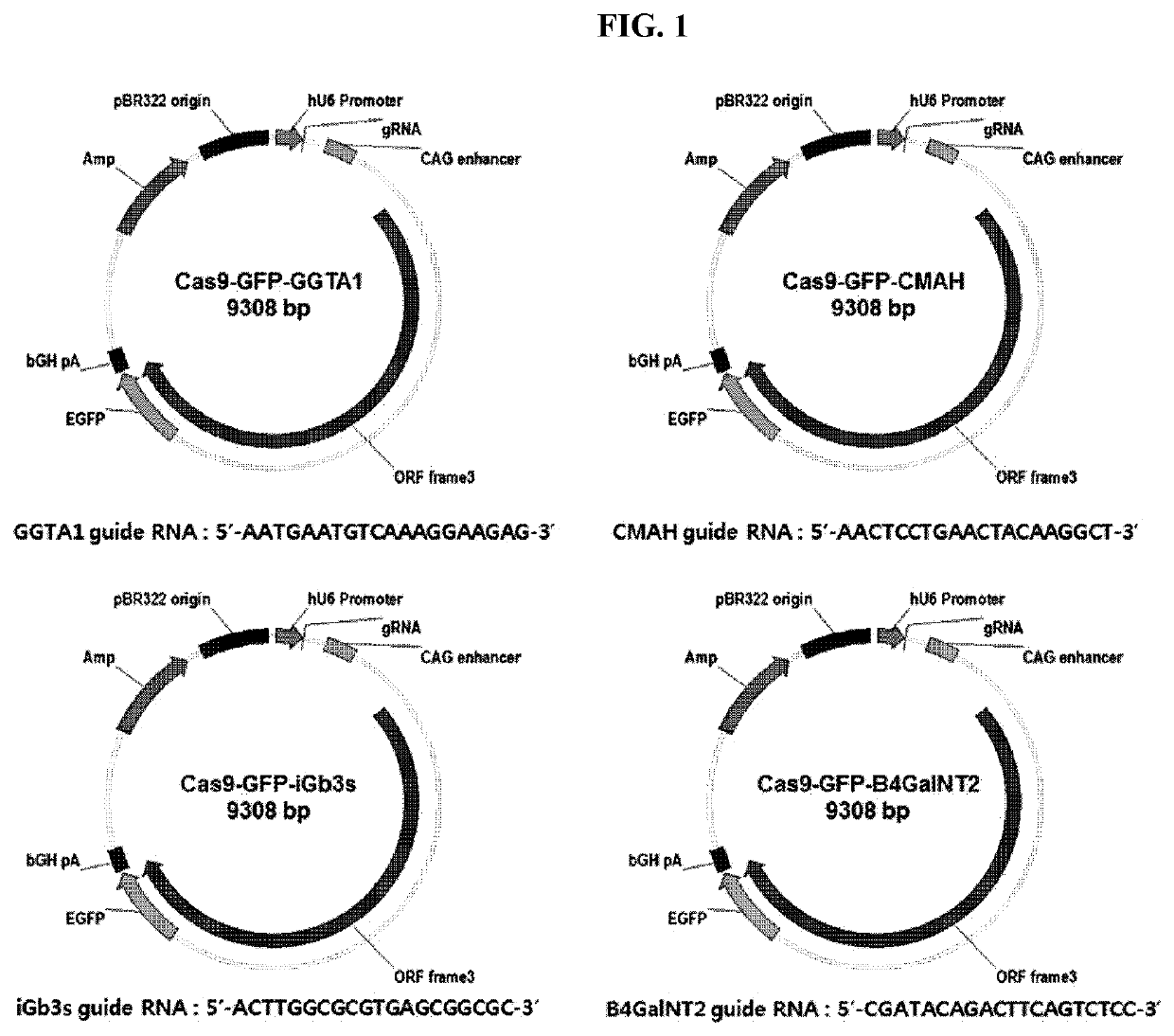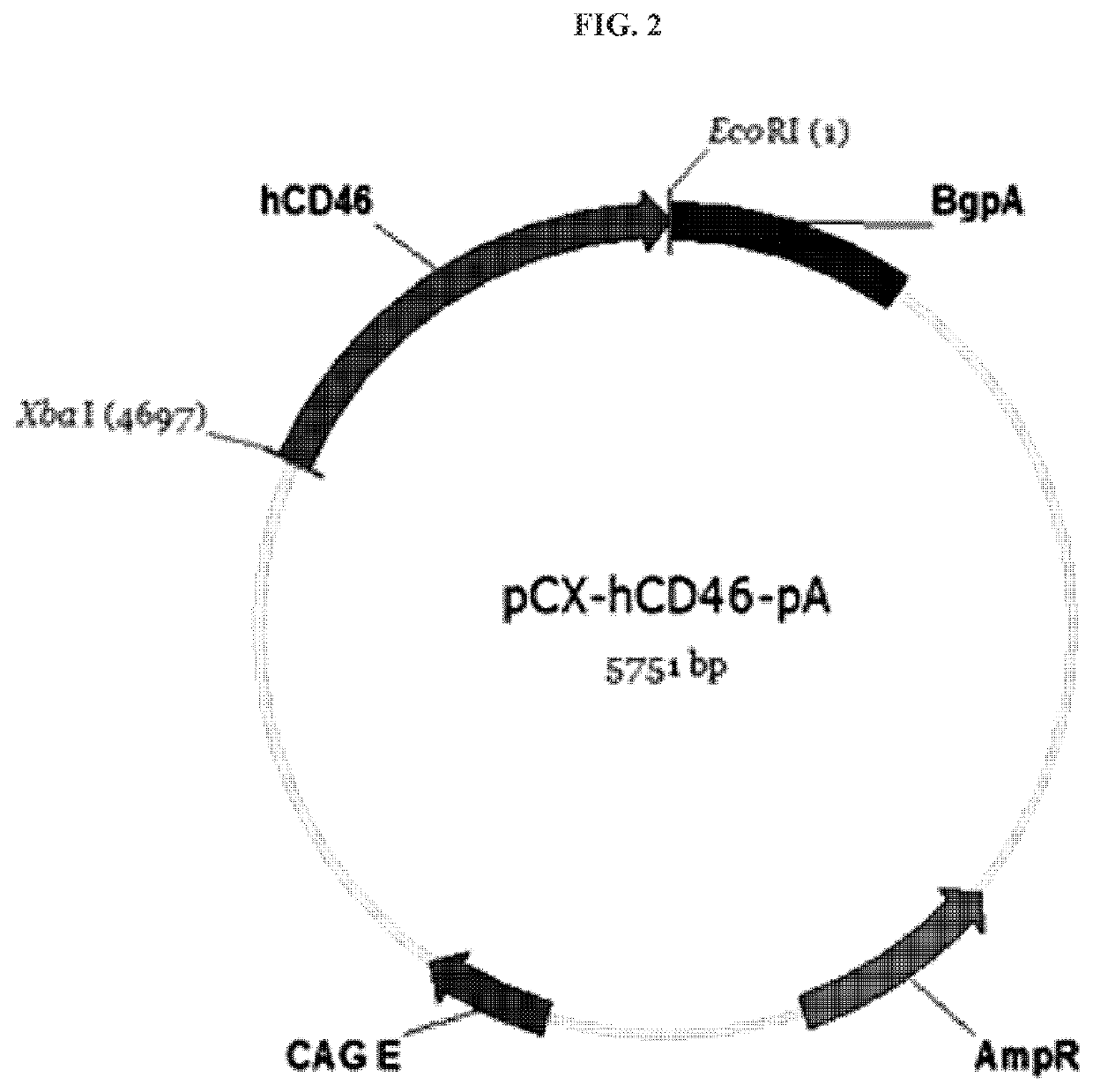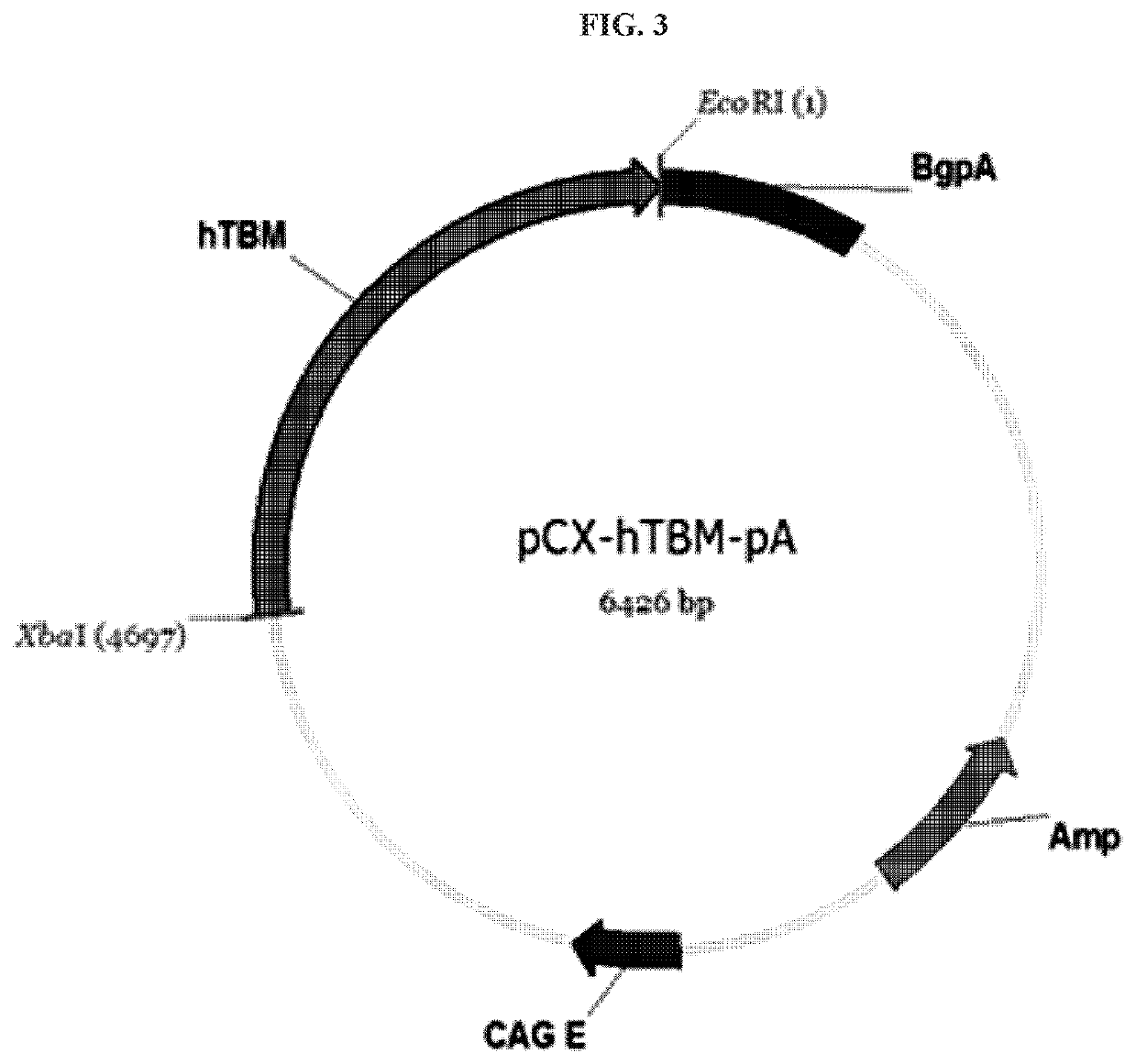TRANSGENIC CLONED PIG FOR XENOTRANSPLANTATION EXPRESSING HUMAN CD46 AND TBM GENES, IN WHICH PORCINE ENDOGENOUS RETROVIRUS ENVELOPE C IS NEGATIVE AND GGTA1, CMAH, iGb3s AND ß4GalNT2 GENES ARE KNOCKED OUT, AND METHOD FOR PREPARING SAME
a technology of thrombomodulin and pigs, which is applied in the field of transgenic cloned pigs for xenotransplantation expressing human cd46 and tbm genes, can solve the problems of large problem, gap between supply and demand, and increase every year
- Summary
- Abstract
- Description
- Claims
- Application Information
AI Technical Summary
Benefits of technology
Problems solved by technology
Method used
Image
Examples
example 1
on of GGTA1, CMAH, iGb3s and β4GalNT2 Gene Targeting Vectors
[0063]To knock out the porcine GGTA1, CMAH, iGb3s and β4GalNT2 genes, the nucleotide sequence of each of the genes was analyzed. Then, a nucleotide sequence site of the exon to which gRNA may bind was determined based on the analysis result. In this connection, gRNAs for gene targeting did not simply use known gRNAs. Rather, via a screening process, the exon site that may maximize gene targeting efficiency was determined, and gRNA having excellent effects at the corresponding exon site was selected. The gRNA selected via the above process was synthesized by Bioneer for insertion into the vector (SEQ ID NOs: 1 to 4). Table 1 shows the sequence of the gRNA relative to each of the genes, NCBI accession number, chromosomal location, and exon location.
TABLE 1SEQGeneChromosomeExon RNA sequence (5′-3′)1GGTA114AATGAATGTCAAAGGAAGAG2CMAHNM_0011130015.179AACTCCTGAACTACAAGGCT364ACTTGGCGCGTGAGCGGCGC4β4GalNT2221CGATACAGACTTCAGTCTCC2) in...
example 2
of Human CD46 and TBM Gene Expression Vectors
[0065]For the construction of human CD46 and TBM gene expression plasmid vectors, nucleotide sequences of Genbank number D84105.1 (human CD46) and Genbank number J02973.1 (human TBM) were respectively amplified based on the sequences disclosed in NCBI.
[0066]More specifically, while a primer (human CD46: forward primer (SEQ ID NO: 13): 5′-TATCTAGAATGGAGCCTCCCGGC-3′, reverse primer (SEQ ID NO: 14): 5′-CGGATATCTATTCAGCCTCTCTGCTCTGCTGGA-3; Human TBM: forward primer (SEQ ID NO: 15): 5′-CCTGGGTAACGATATCATGCTTGGGG-3′, reverse primer (SEQ ID NO: 16): 5′-GACGGAGGCCGAATTCGCTCAGAGTC-3′) with an XbaI restriction enzyme sequence inserted into the 5′ terminal thereof and an EcoRI restriction enzyme sequence inserted into the 3′ terminal thereof for cloning using a restriction enzyme, and human cDNA library were used as a template, gene amplification was executed using pfu taq polymerase. After A-tailing each PCR product as prepared, TA-cloning was perf...
example 3
of Individual in which Porcine Endogenous Retrovirus Envelope C is Negative
[0067]In order to select an individual in which the porcine endogenous retrovirus envelope C was negative, genomic DNA was extracted from each individual, and then PCR was performed using the primer pairs shown in Table 3. More specifically, after obtaining ear tissues for each individual, each genomic DNA was extracted therefrom using the Dneasy Blood & tissue kit (QIAGEN, Germany). After reacting using the extracted genomic DNA and primers for initial denaturation at 95° C. for 5 minutes, a total of 35 cycles of 40 seconds at 95° C., 40 seconds at 61° C., and 1 minute at 72° C. were repeated. Finally, the reaction was carried out at 72° C. for 7 minutes. The PCR results were loaded on a 2% agarose TAE gel, and the results are shown in FIG. 4.
TABLE 3GenePrimer (5′-3′)Size (bp)SEQ ID NO.PERV F: GGAAGCAGCTATGTGGTGCAAG70817R: CACAATGTTTGACCACCCAGTC18PERV EnvAF: CTGCCTTCGATCAGTAATCCCT60619R: GGGGACTGATCCAGAGGTTG...
PUM
| Property | Measurement | Unit |
|---|---|---|
| temperature | aaaaa | aaaaa |
| temperature | aaaaa | aaaaa |
| temperature | aaaaa | aaaaa |
Abstract
Description
Claims
Application Information
 Login to View More
Login to View More - R&D
- Intellectual Property
- Life Sciences
- Materials
- Tech Scout
- Unparalleled Data Quality
- Higher Quality Content
- 60% Fewer Hallucinations
Browse by: Latest US Patents, China's latest patents, Technical Efficacy Thesaurus, Application Domain, Technology Topic, Popular Technical Reports.
© 2025 PatSnap. All rights reserved.Legal|Privacy policy|Modern Slavery Act Transparency Statement|Sitemap|About US| Contact US: help@patsnap.com



